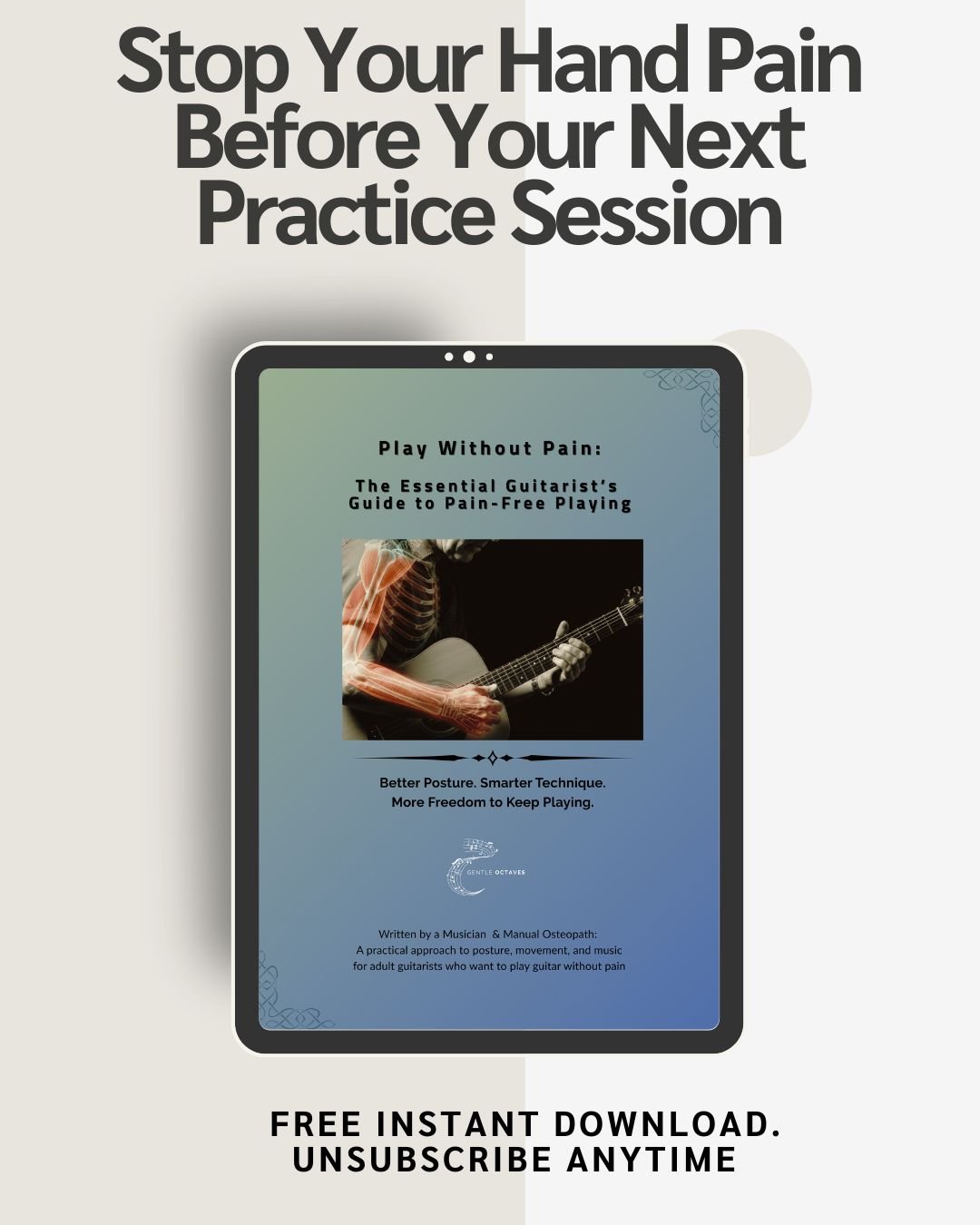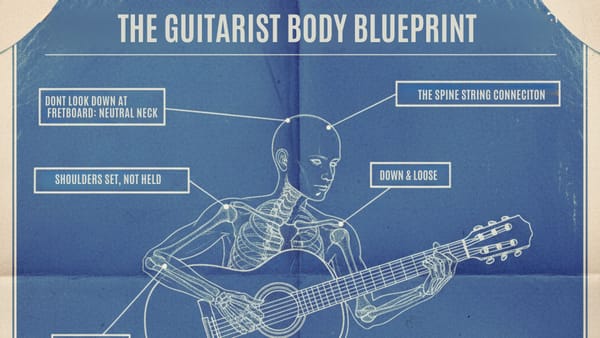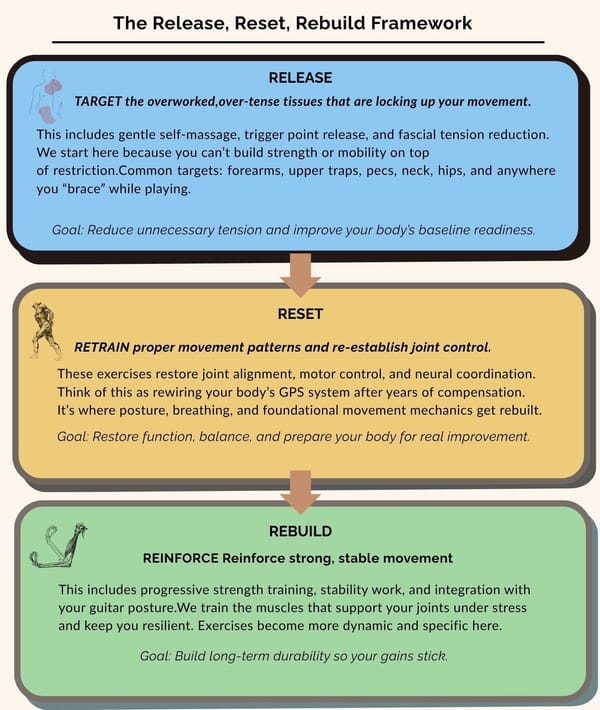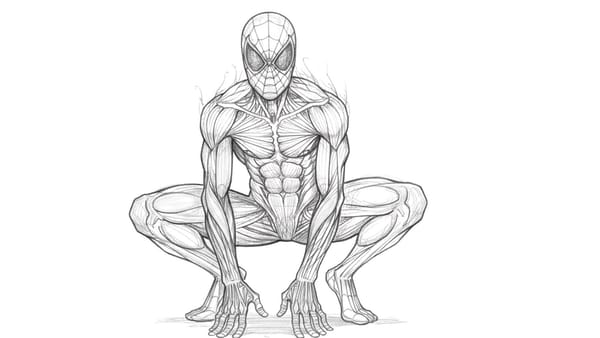Musicians and Shoulder Pain: Stop Treating the Symptom, Start Fixing the Pattern
Stop treating the symptom. Start fixing the pattern.

Pain is rarely random. And your shoulder? It's not the villain: it's taking the hit for something else.
Maybe you stretch it. Maybe you rest it. Maybe you ice it, massage it, take ibuprofen, try everything the internet suggests.
And still, your shoulder aches.
It shows up when you play. When you sleep. Sometimes even before you pick up your guitar or just thinking about playing is enough to trigger that familiar tightness.
It wears you down. Not just physically. Emotionally. Creatively.
It whispers things you don't want to hear:
"Maybe I'm just not built for this anymore."
"Maybe it's time to stop."
"Maybe this is just what happens when you get older."
But here's what most musicians don't realize: pain is rarely random. And your shoulder? It's not the villain. It's the messenger.
It's trying to tell you something about what's happening upstream: in your spine, your breathing, your core, your nervous system. And until you address those root causes, until you fix the compensation patterns that put your shoulder in that position in the first place, the pain will keep coming back.
In this post, I'm going to help you stop chasing the pain and start addressing the root cause: the hidden compensation patterns that keep your shoulder stuck and your playing limited.
The Pain That Shows Up Before the Playing Starts
Let's name something that doesn't get talked about enough: pre-game pain is brutal.
You haven't even strummed a chord yet. You haven't sat down at the piano. You haven't started your warm-up. And your body's already complaining.
You want to play. You need to play. It's one of the few things that brings you joy, that lets you express what words can't, that connects you to something bigger.
But the ache makes you hesitate.
So you avoid it. You tell yourself you'll play later, when you feel better. But later doesn't come. Or when it does, the pain's still there.
Your guitar stays in the case. The piano becomes a shelf for candles and picture frames. And slowly, that creative spark starts to dim.
And here's the thing: this isn't just about pain anymore. It's about doubt.
The kind that whispers, "My shoulder just can't handle it anymore."
The kind that keeps you from even trying again.
The kind that makes you wonder if you've lost access to the thing that used to make you feel most alive.
So the thing that brings you joy gets pushed aside because it's just not worth the hassle or the pain anymore.
I've seen this pattern so many times. Players who used to practice daily, who loved losing themselves in music, who found meaning and purpose and peace in playing now avoiding it. Because their body's become the barrier instead of the bridge.
And that frustrates me, because it doesn't have to be that way.
Sometimes Your Shoulder Isn’t the Problem
Most players think the source of the pain is the problem. Makes sense, right? If my shoulder's sore, then surely something in my shoulder isn't working as it should.
But in truth? Sometimes the shoulder is just the one taking the hit.
Your body's a system. A chain. Everything's connected. And when one part of the chain isn't doing its job, the other parts have to pick up the slack.
So let me show you what this actually looks like:
When Your Spine Slumps
You're sitting at your desk all day. Or slouched on the couch. Your spine rounds forward, your chest collapses, your head juts out in front of your shoulders.
Now your body needs to keep your head upright because if it didn't, you'd be staring at your lap all day. So what happens?
Your upper trapezius, levator scapulae, and deep cervical extensors jump in.
They work overtime to lift your head and pull your shoulders back toward something resembling upright.
They weren't designed to do this job all day. But they adapt. They compensate. And eventually, they get tired, tight, and angry.
That tension? It shows up as shoulder pain. Neck pain. Headaches. But the problem isn't your shoulder. It's your posture.
When Your Core Gets Tired
You don't have great core stability. Maybe you never trained it. Maybe you had an injury.
Maybe you just spend most of your day sitting, and your core's learned to check out.
So when you're playing, when you need stability to support your arms and hold your posture your body has to find it somewhere.
Your lumbar extensors, multifidus, and scapular stabilizers (serratus anterior, rhomboids, upper traps) over-recruit.
They brace your trunk. They lock down to create stability that your core should be providing.
And again, that shows up as shoulder tension. Shoulder pain. Upper back tightness. But the problem isn't your shoulder. It's your core not doing its job.
When Your Breathing Gets Shallow
You're stressed. You're focused. You're concentrating hard on that tricky passage. And without realizing it, your breathing gets shallow.
You start breathing up into your chest instead of down into your belly.
Now your accessory breathing muscles have to do the heavy lifting.
Your scalenes, your sternocleidomastoid, your upper trapezius: they all kick in to help lift your ribcage and get air into your lungs.
But they're not primary breathing muscles. They're supposed to be backup singers, not the lead vocalist.
And when they're working overtime with every single breath, they get exhausted.
And where does that show up? Shoulder tension. Neck tightness. That feeling like you're carrying the weight of the world on your shoulders.
But the problem isn't your shoulder. It's your breathing pattern.
The Real Root: Compensation
A lot of chronic pain in adult musicians comes from repetition without reset.
You develop a faulty pattern, maybe from poor posture, maybe from an old injury, maybe from stress or fatigue.
And then you repeat that pattern. Over and over. Day after day. Week after week. Year after year.
Your nervous system learns it. Reinforces it. Makes it the default.
And here's what happens: your nervous system is always scanning for stability.
It's always asking, "Are we safe? Are we supported? Can we do what's being asked of us?"
If the answer is no: if it feels unsafe, even subtly it goes into protection mode:
- Bracing. Locking down. Creating rigid stability because fluid stability isn't available.
- Gripping. Holding tension in anticipation of threat or demand.
- Locking up. Restricting movement to avoid positions that feel vulnerable.
One small shift leads to a full-body pattern. And the shoulder gets caught in the middle, doing overtime for the whole chain.
But here's the good news:
What was learned can be unlearned.
What adapted can re-adapt.
Your nervous system is plastic. It can change. It can learn new patterns. You just have to give it the right input, the right feedback, the right environment to rewire.
That's what this work is about. Not just treating symptoms. But fixing the patterns that created the symptoms in the first place.
3-Minute Pattern Reset: Try This Today
You don't always need to push harder. You need to rewire the signal.
This simple practice interrupts the compensation pattern and gives your nervous system new information.
Do it before you play. Do it when your shoulder starts talking to you. Do it whenever you notice tension building.
Here's how:
- Sit upright: spine tall, feet grounded flat on the floor. Feel your sit bones making contact with the chair.
- Take 3 slow breaths into your lower ribs. Not your chest. Your ribs. Feel them expand sideways and backward. This activates your diaphragm and takes the load off your accessory breathing muscles.
- On each exhale, gently let your shoulder blades slide down your back. Not forcing. Just inviting. Like they're melting. Feel the space that creates.
- Slowly raise your arms like a conductor, not a weightlifter. Smooth, light, coordinated. Notice if one side feels heavier or less coordinated. That's information.
- Notice: More space? Less tension? Just observe. Don't judge. Just notice what's different.
Optional add-on: Hum a low note as you move.
It gives your nervous system another safety signal. Humming stimulates the vagus nerve, which helps downregulate stress and tension.
This is the Release → Reset → Rebuild™ method in action.
You're not forcing change. You're not pushing through pain.
You're giving your body permission to let go of the protective pattern and move differently.
Do this consistently every day for two weeks and you'll start to notice shifts.
Not just in your shoulder. But in how your whole upper body moves and feels.
Pain Is Feedback, Not Fate
If you take one thing away from this post, let it be this:
Pain isn't punishment. It's information.
It's your system saying, "Something needs to change."
Not "You need to stop." Not "You're broken." Not "It's over."
Just: "Pay attention. Adjust. Find another way."
And most of the time, that adjustment isn't where you think it is. It's not in the place that hurts. It's upstream. It's in the patterns that created the compensation in the first place.
You don't need to learn to live with pain. You need to learn to move smarter. To breathe better. To support your body the way it's designed to be supported.
The right approach can turn protection back into performance.
And that's not hype. That's just understanding how the body works and respecting what it needs to heal.
Your Invitation
If you're ready to stop working around your pain and start working through it, I've got two ways to help:
Option 1: Start Free
Download the free guide: Play Without Pain
You'll learn:
- The 7 pillars of guitar posture that actually matter
- How to warm up properly (release work built into your practice)
- Daily hand stretches to prevent tension and overuse
- Fretting and strumming technique that protects your joints
- A repeatable, pain-free practice routine for consistent progress
- Warning signs to look out for before pain becomes injury
Option 2: Go Complete
Get the full system: Keep Playing: A Recovery System for Guitarists Over 40
This is the complete handbook with the entire Release → Reset → Rebuild framework:
- Phase-by-phase exercises with clear progressions
- Troubleshooting for specific pain patterns
- Video demonstrations and visual guides
- Nervous system regulation practices
- Long-term maintenance strategies
Start your recovery with the guide built for guitarists over 40.
No fluff. No gimmicks. Just the sequence that actually works.If you're dealing with pain whether it's chronic or just starting to creep in I'd love to hear what's going on for you.
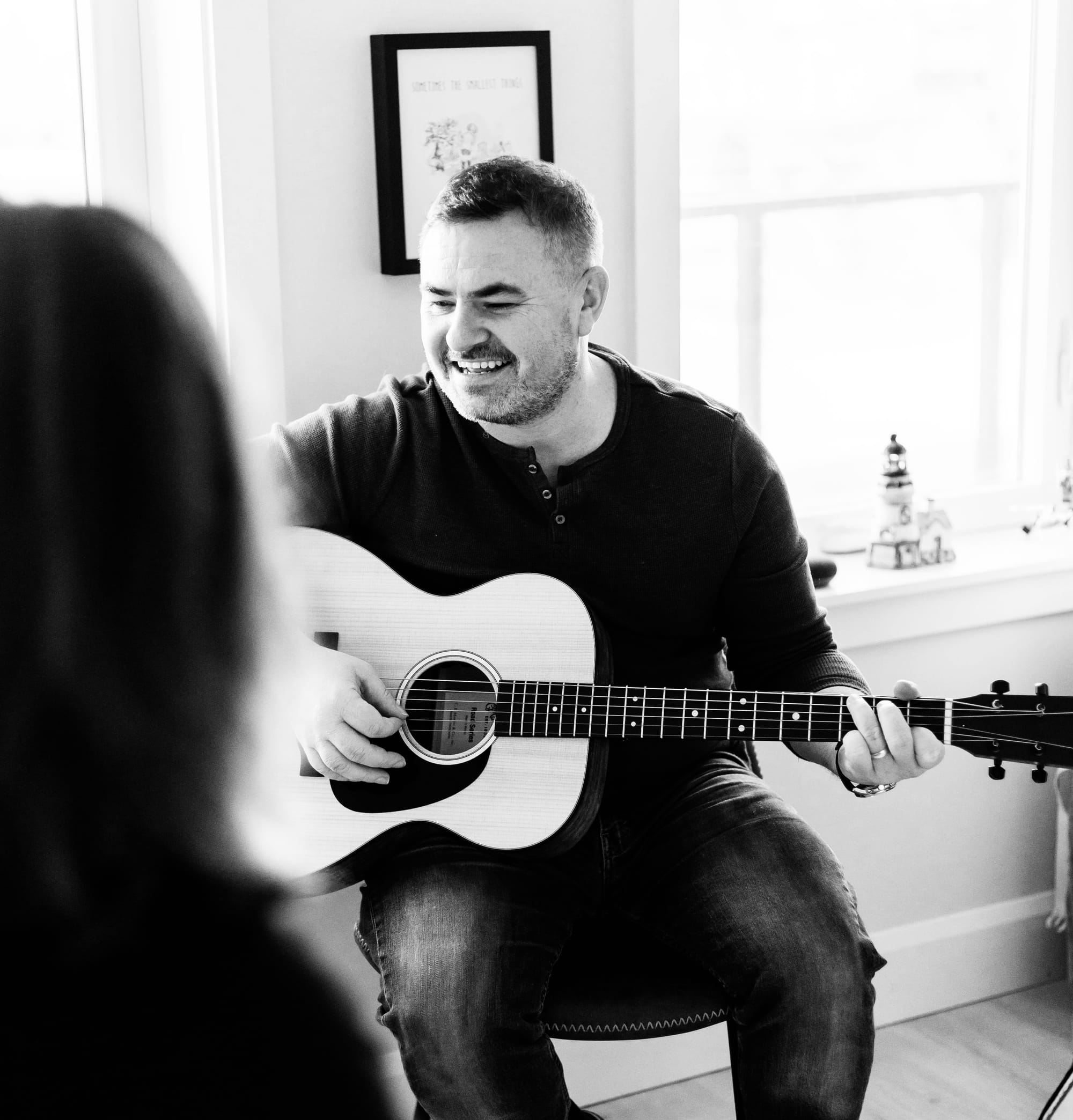
F.P. O’Connor
F.P. O’Connor is a manual osteopath, psychology grad, and lifelong musician who helps adults play with less pain and more confidence.
Through Gentle Octaves Studio, he blends science, movement, and musicianship to help mature players keep creating for life.
FAQ
Q: Why does my shoulder hurt even when I don't play?
A: It's often compensation from posture, breathing, or spine misalignment — not the shoulder itself. Your shoulder's working overtime to stabilize what your core or spine should be stabilizing. The pain persists because the pattern persists, even when you're not playing.
Q: Can I still play if I have shoulder pain or arthritis?
A: Yes. With smart modifications and pattern resets, many players improve dramatically. The key is addressing the root cause, not just managing symptoms. I've seen chronic shoulder pain resolve completely once we fixed the upstream dysfunction.
Q: What's the best posture for shoulder relief while playing?
A: Sit tall with feet flat, breathe into your lower ribs (not your chest), and keep the guitar close to your body. Avoid hunching or leaning into the fretboard. Your shoulder should feel supported by your core and spine, not carrying the whole load.
Q: How long does it take to fix shoulder compensation patterns?
A: You'll notice some immediate relief with postural and breathing adjustments. But rewiring deep patterns takes 4-6 weeks of consistent practice. Your nervous system needs time to learn the new way is safe and sustainable.
Q: Should I stop playing completely until the pain goes away?
A: Usually no. Complete rest often makes things worse because your body loses conditioning and the patterns don't change. Instead, reduce intensity and duration, focus on the pattern reset work, and gradually rebuild. Movement is medicine when done smartly.
Sources & Science
- Journal of Orthopaedic & Sports Physical Therapy. (2019). Scapular dyskinesis and shoulder pain in musicians.
- Clinical Biomechanics. (2020). Postural compensation patterns in chronic upper extremity pain.
- Medical Problems of Performing Artists. (2018). Breathing dysfunction and musculoskeletal pain in performers.
- Physical Therapy. (2021). Core stability and upper extremity function: A systematic review.


